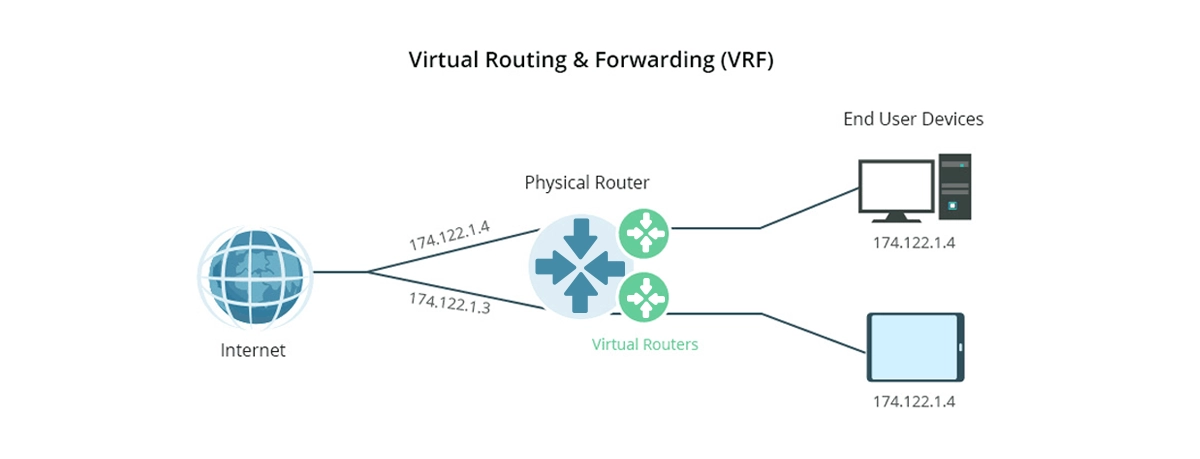
In today's complex digital landscape, network security, scalability, and efficient resource utilization are not just goals—they are necessities. As organizations grow and evolve, so do their networks, often leading to sprawling, hard-to-manage infrastructures. Enter Virtual Routing and Forwarding (VRF), a powerful technology that brings order, security, and flexibility to modern networks. This guide will demystify VRF, explore its inner workings, and show you how to leverage it effectively, including how high-performance components like LINK-PP's optical transceivers play a crucial role.
📄 What Exactly is Virtual Routing and Forwarding (VRF)?
At its core, Virtual Routing and Forwarding is a technology that allows multiple instances of a routing table to coexist simultaneously on a single physical router. Think of it as creating multiple, independent virtual routers within one piece of hardware. Each VRF instance is completely isolated from the others, with its own unique routing table, interfaces, and forwarding policies.
This isolation is the key. Without VRF, all interfaces on a router share a single global routing table. VRF changes this paradigm, enabling network administrators to create segmented network paths over the same physical infrastructure. This concept is fundamental for advanced network segmentation strategies and is a cornerstone of modern MPLS (Multiprotocol Label Switching) networks.
📄 How Does VRF Work? The Magic of Isolation
VRF creates logical partitions within a router. Here's a simplified breakdown of the process:
Instance Creation: An administrator defines separate VRF instances (e.g., VRF_CORP for corporate traffic and VRF_GUEST for guest Wi-Fi).
Interface Assignment: Physical or logical interfaces are assigned to a specific VRF. An interface belonging to VRF_CORP cannot see or communicate with interfaces in VRF_GUEST without an explicit configuration to do so.
Independent Routing Tables: Each VRF maintains its own IP routing table. This means that the same IP subnet can exist in multiple VRFs without causing any conflict—a feature known as overlapping IP address support.
Forwarding: When a packet arrives on an interface assigned to a VRF, the router consults only that VRF's routing table to make a forwarding decision. This ensures total separation of data planes.
This mechanism is invaluable for multi-tenant architectures, allowing service providers or large enterprises to serve different departments or customers securely on shared hardware.

📄 Key Benefits of Implementing VRF in Your Network
Adopting a VRF-based design offers a multitude of advantages:
✅ Enhanced Security: By isolating network segments, VRF contains security breaches. An issue in one VRF won't spread to others.
✅ Efficient Use of Infrastructure: Maximize ROI by consolidating multiple logical networks onto a single physical device, reducing capital and operational expenditures.
✅ Simplified Network Management: While it introduces initial complexity, VRF ultimately simplifies management by providing clear boundaries for different services or user groups.
✅ Support for Overlapping IP Addresses: Crucial for managed service providers (MSPs) or during mergers and acquisitions, where separate entities may use the same private IP ranges.
📄 VRF Use Cases: Where Does It Shine?
VRF is incredibly versatile. Here are some of the most common applications:
Multi-Tenant Data Centers: Isolating customer environments securely on shared infrastructure.
Enterprise Network Segmentation: Separating departments like Finance, HR, and R&D for compliance and security.
Network Mergers: Facilitating the seamless integration of two company networks without readdressing.
Internet of Things (IoT): Creating a separate VRF for IoT devices to limit their access to the core corporate network.
📄 The Role of Optical Transceivers in a High-Performance VRF Network
A robust logical network relies on a high-performance physical layer. This is where optical transceivers come into play. In a VRF-enabled network, especially in data center or service provider backbones, high-speed, reliable fiber optic connections are essential for carrying the segregated traffic between switches and routers.
Transceivers like the SFP+ (10 Gigabit Small Form-factor Pluggable) and QSFP28 (100 Gigabit) modules are the workhorses that transform electrical signals into light, transmitting data over fiber optic cables. Their performance directly impacts the reliability and speed of your VRF instances.
For a VRF design demanding low latency and high bandwidth, choosing a reliable supplier is paramount. This is an area where LINK-PP excels. Their optical modules are engineered for stability and compatibility, ensuring that your logical network segmentation is backed by a resilient physical foundation. For instance, integrating the LINK-PP SFP-10G-SR transceiver into your core switches provides a dependable 10G connection for inter-VRF routing links, guaranteeing that your segmented data flows smoothly and without interruption.
💡 Pro Tip: When designing a VRF network, always ensure your optical hardware, including transceivers, is from a trusted vendor. High-quality modules from LINK-PP prevent physical layer issues that could undermine the logical isolation provided by VRF.
📄 VRF vs. Traditional Routing: A Quick Comparison
The table below highlights the fundamental differences between VRF and traditional routing.
Feature | Virtual Routing and Forwarding (VRF) | Traditional Routing |
|---|---|---|
Routing Tables | Multiple, independent instances | Single, global table |
Address Space | Supports overlapping IP addresses | Requires unique IP addresses |
Isolation | Logical isolation at Layer 3 | No inherent logical isolation |
Use Case | Multi-tenant, complex enterprises | Simpler, flat networks |
Security | Higher (breach containment) | Lower (broadcast domain reliance) |
Management | More complex initial setup, simpler long-term segmentation | Simpler initial setup, can become complex |
📄 Conclusion: Segment Smarter with VRF
Virtual Routing and Forwarding (VRF) is more than just a networking feature; it's a strategic approach to building secure, scalable, and efficient modern networks. By logically dividing your network, you gain unparalleled control, enhance security, and future-proof your infrastructure.
As you plan your network segmentation strategy and look for reliable hardware to support it, remember that a successful implementation depends on both smart logical design and robust physical components.
Are you ready to design a more secure and efficient network architecture with VRF? 🔗
Contact the LINK-PP experts today to discuss your project needs. Discover how our high-performance networking solutions, including our industry-leading LINK-PP SFP-10G-LR and QSFP-28-100G-SR4 optical transceivers, can provide the reliable foundation your VRF deployment requires. Let's build a smarter network together
📄 FAQ
What is a VRF instance?
A VRF instance is a virtual router inside your device. You use it to keep network traffic separate and secure.
What makes VRF different from VLAN?
You use VLANs to split networks at Layer 2. You use VRF to split networks at Layer 3. VRF gives each network its own routing table.
What can you do with VRF in your network?
You can create private networks for customers, departments, or cloud tenants. You use VRF to improve security and manage traffic paths.


